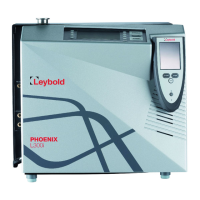
Do you have a question about the LEYBOLD PHOENIX L300i and is the answer not in the manual?
| Type | Helium Leak Detector |
|---|---|
| Minimum Detectable Leak Rate (Helium) | 5 x 10^-12 mbar l/s |
| Pumping Speed for Helium | 2.5 l/s |
| Power Supply | 100-240 V AC, 50/60 Hz |
| Detection Principle | Mass Spectrometer |
| Field of View | Not applicable |
| Operating Voltage | 100-240 V AC |
| Protection Rating | IP20 |
| Interface | RS232, Ethernet |
| Output Type | Digital |
| Operating Temperature | 10°C to 40°C |
| Detection Range | 5 x 10^-12 to 0.1 mbar l/s |
Overview of the leak detector's mechanical and functional design.
Illustrates the internal vacuum system components and flow for the PHOENIX L300i.
Details the vacuum system for the PHOENIX L300i DRY version.
Shows the vacuum system for the PHOENIX L300i MODUL variant.
Explains the procedure for leak detection using the vacuum method.
Describes the leak detection process using an auxiliary pump.
Details how to use the unit as a sniffer leak detector.
Presents key technical specifications and performance data of the instrument.
Lists part numbers and product codes for ordering.
Lists optional accessories available for purchase.
Outlines the factory default parameter settings for the instrument.
Guidance on unpacking, inspecting, and positioning the leak detector.
Defines the intended use and limitations of the PHOENIX L300i leak detector.
Specifies permissible environmental conditions for operation.
Instructions for connecting the instrument to the mains power supply.
Details the requirements and safety measures for connecting to mains power.
Details connections for external controllers and accessories via option ports.
Explains how to connect vacuum hoses to the inlet, exhaust, and vent ports.
Information on suitable gases and purge gas usage.
Step-by-step guide for initial power-on and preparation for measurement.
Explains the functions and information presented on the instrument's display.
Describes the display mode showing leak rate numerically with a bargraph.
Describes the display mode showing leak rate over time.
Procedure to verify initial operation and perform calibration.
Overview of the instrument's control panel buttons and display interface.
Configuration options for communication interfaces like RS232 and PLC.
Navigation through the instrument's main menu structure.
Selection of operating modes, such as Vacuum or Sniff.
Configuration of trigger levels, alarms, and audio settings.
Access to various internal machine parameter settings.
Manages user access and restrictions to instrument functions.
Crucial safety precautions to be followed during maintenance.
Recommended schedule and tasks for routine maintenance.
General procedures for performing maintenance tasks.
Steps for safely opening the leak detector housing.
Instructions for replacing the air filter mats.
Procedure for replacing internal fuses.
Steps for cleaning or replacing the exhaust oil filter.
Information about the calibrated leak used for alignment and calibration.
General advice and indicators for diagnosing issues.
Comprehensive list of error and warning codes with solutions.
Guidelines for the safe and compliant disposal of contaminated parts and equipment.
Contains the EU Declaration of Conformity for the product.